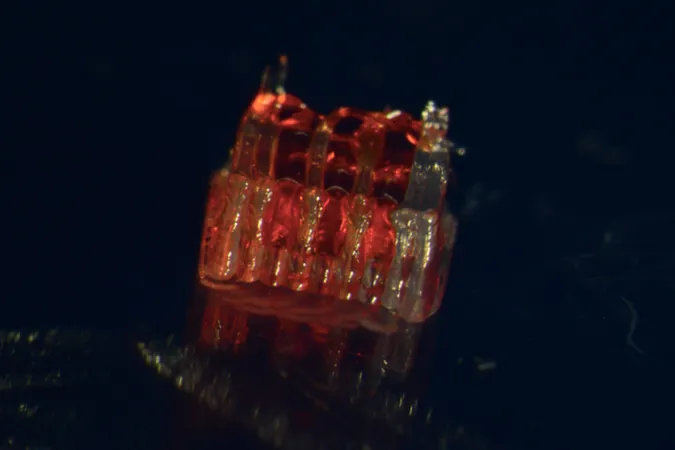
Revolutionary 3D Printed Scaffolds Show Promise in Spinal Cord Repair for Rats
2025-08-27
Author: Siti
A Groundbreaking Approach to Spinal Cord Injuries
Researchers at the University of Minnesota have unveiled an innovative technique to tackle spinal cord injuries, a condition that afflicts over 300,000 individuals across the U.S. and often leads to debilitating paralysis. Their study, published in Advanced Healthcare Materials, highlights the use of 3D printed scaffolds infused with spinal neural progenitor cells (sNPCs), which have shown promising results in restoring partial movement in rats with severe spinal cord injuries.
Creating a Supportive Framework for Healing
Typically, sNPCs struggle to connect and form organized networks on their own; they tend to scatter when injected. To address this, the research team, led by neurosurgery expert Dr. Ann M. Parr, designed a custom 3D printer to produce silicone scaffolds with intricate channels that mimic the structure of the spinal cord. This scaffold serves not only as a physical support but also as a guide for the cells' growth.
The Science Behind the Scaffolds
The scaffolds were meticulously engineered to host human induced pluripotent stem cells that had been converted into sNPCs. These cells were placed in specialized channels filled with a supportive gel, allowing them to grow in a targeted manner. Within weeks, sNPCs developed into various types of neurons pivotal for motor function. Imaging technologies demonstrated the formation of interconnected networks of axons across the scaffolds.
Transformative Results in Animal Trials
Encouraged by their laboratory results, the team moved on to animal trials, placing scaffolds into spinal cord gaps in rats. What they observed over the course of 12 weeks was extraordinary: the treated rats began to regain movement in their hind limbs, in stark contrast to control groups that received no scaffolding. Electrical recordings confirmed that signals from the brain navigated across the injury site to activate muscle movement.
What’s Next for Spinal Repair Innovation?
Although these findings are still in preliminary stages and rely on temporary silicone scaffolds, the researchers are optimistic. Future studies will explore biodegradable materials that dissolve naturally as tissue regenerates. Additionally, plans are in place to introduce other cell types to recover not just motor function but sensory abilities too.
The Future of Spinal Repair Technology
The Minnesota team's advancement reflects a growing trend in spinal repair research using 3D printing technology. Other research institutions are also innovating in this domain. For instance, teams in Ireland and California are developing unique 3D printed implants that combine soft tissue matrices with conductive fibers to stimulate nerve growth or use rapid manufacturing techniques to restore movement in injured rats, demonstrating various paths towards potential human applications.
With continued developments and collaboration, the dream of restoring function to spinal cord injury patients may soon be a reality.



 Brasil (PT)
Brasil (PT)
 Canada (EN)
Canada (EN)
 Chile (ES)
Chile (ES)
 Česko (CS)
Česko (CS)
 대한민국 (KO)
대한민국 (KO)
 España (ES)
España (ES)
 France (FR)
France (FR)
 Hong Kong (EN)
Hong Kong (EN)
 Italia (IT)
Italia (IT)
 日本 (JA)
日本 (JA)
 Magyarország (HU)
Magyarország (HU)
 Norge (NO)
Norge (NO)
 Polska (PL)
Polska (PL)
 Schweiz (DE)
Schweiz (DE)
 Singapore (EN)
Singapore (EN)
 Sverige (SV)
Sverige (SV)
 Suomi (FI)
Suomi (FI)
 Türkiye (TR)
Türkiye (TR)
 الإمارات العربية المتحدة (AR)
الإمارات العربية المتحدة (AR)